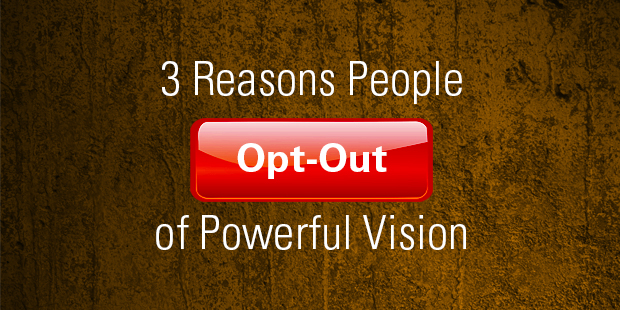
3 Reasons People Opt-Out of Powerful Vision
Frustrated that you feel like you’re casting an incredible vision…but nobody seems to be following?
It’s happened to all of us.
Usually, when a leader casts vision and it doesn’t ignite people’s imagination, there’s a good reason. Sure, it could be you have a bad vision or a bad plan of action. But let’s just assume you’re past that. You’ve got a great vision. It just didn’t ignite people.
There are times when all of us cast vision for something we’re excited about but hear crickets.
Here are three common pitfalls I’ve noticed when that happens.
1. You didn’t create a deep sense of urgency
Often the difference between attention and indifference is urgency.
Next time you’re on a plane, watch what happens when the flight attendant reviews the emergency oxygen and evacuation procedures.
Answer? Not much.
Most people are tuned out, dozing, reading or otherwise distracted. I’ve always felt for flight attendants. I’m sure they realize most people aren’t listening. Some have even adopted the monotone of a person who is saying something for the thousandth time to a disengaged audience.
It’s not that the information isn’t important, it’s just that it doesn’t seem urgent.
Why? Very few people actually expect the plane to crash.
When urgency is low, so is the motivation to listen and respond.
Just imagine the same announcement mid-air during an episode of luggage-crunching turbulence. How attentively are people listening now?
The only thing that’s changed is urgency.
Somehow information that was of possible use at some point has become essential at this point – maybe even life-saving. You’re going to remember and act on every word you can.
Leadership is no different. You might be sharing what you think is critical information with your team or entire organization, but if there’s no urgency, the motivation to listen to and act on it is low. Very low.
That’s why effective leaders learn to establish a sense of urgency when they speak.
While there are many factors that make up effective communication, leaders almost always communicate with a sense of urgency. Urgency creates a hearing. And urgency demands a response.
How deep is the sense of urgency when I communicate?
If the answer is ‘not very’, then don’t be surprised when people fail to respond.
2. You focused on the what, not on the why
As a leader, you get really excited about what you’re doing, but you take why you’re doing it for granted. You know, and you assume everyone else does too.
One of the best communication techniques you can adopt is what I call the why sandwich.
In any vision communication piece (talk, email, blog post):
- Start with why
- Talk about the what
- Touch briefly on the how
- Close with why
This simple formula connects with people again and again.
Why unites. Why reminds us why we do what we do and what unites everyone in the room. It calls us back to the mission we all agreed we were on.
What and how divide. People who agree on the mission might disagree on how to accomplish or even what to do.
So if you only talk about what and how, you tend to divide people as much as you unite them. But it’s deeper than that.
Even if everyone agreed on what and how, the agreement can be followed by a so what, as in, ‘well, that’s great, but so what? Why should I care???”
Starting with why and ending with why remind people what’s at stake, why it matters and why all of this is so critical.
Simon Sinek is right, people don’t buy what you do, they buy why you do it.
So start and end with why. Always.
3. You didn’t ask for a response
I’ve been caught on this too many times.
A friend of mine who heard me cast vision around raising money once told me “Carey, you did a wonderful job inspiring and informing. You did a poor job asking.” He was completely right.
You know why?
I was afraid.
I didn’t want to ask people for money. Even though it was for an amazing cause. Think about it though: ultimately your fear of asking people for things is selfish. Mine was.
I wanted to be liked more than I wanted to be effective.
Big mistake.
Ask. Tell people (specifically) what you want them to do. People respect a call to action.
Be specific, as in ‘What I’d like everyone to today is X. What that means is Y. So will you respond? The cause is too important for you not to.
Yep, that’s bold. But guess what happens when you specifically call people to action?
People respond.
Learn more about casting vision for your organization. Connect with an Auxano Navigator and start a conversation with our team.













